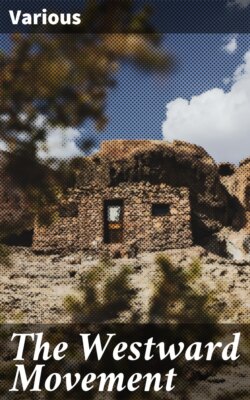Читать книгу The Westward Movement - Various - Страница 8
На сайте Литреса книга снята с продажи.
III. ACROSS THE WATERS.
ОглавлениеTable of Contents
The early American life was primitive, but it was never the life of a peasantry. Once there was a time in the West when every man was as good as his neighbor, as well situated, as much contented. It would take hardihood to predict such conditions in the future for the West or for America.
BEGINNING OF WESTERN RAILWAY TRAVEL—THE AMERICAN ÉMIGRÉ.
At the half-way point of this century the early wheels of the West were crawling and creaking over trails where now rich cities stand.
FIRST WESTERN RAILWAY.
The wagon-wheels had overrun the West before the wheels of steam began the second conquest of the West. Wagons were first used on the Santa Fé trail in 1824, but it was not until three years later that there was begun the first of the Western iron trails.
There were grandfathers in Virginia now, grandfathers in New England. The subdivided farms were not so large. There were more shops in the villages. There was demand for expansion of the commerce of that day. The little products must find their market, and that market might still be American. The raw stuff might still be American, the producer of it might still be American. So these busy, thrifty, ambitious men came up and stood back of the vanguard that held the flexible frontier. Silently men stole out yet farther into what West there was left; but they always looked back over the shoulder at this new thing that had come upon the land.
Thinking men knew, half a century ago, that there must be an iron way across the United States, though they knew this only in general terms, and were only guessing at the changes which such a road must bring to the country at large.
This rapid development of the interior region of America which is a matter of common knowledge to all of us to-day was not foreseen by the wisest of the prophets of fifty years ago.
THE RAILWAYS CHANGE AND BUILD THE COMMERCIAL WEST.
With the era of steam came a complete reversal of all earlier methods. For nearly a century following the Revolutionary War the new lands of America had waited upon the transportation. Now the transportation facilities were to overleap history and to run in advance of progress itself. The railroad was not to depend upon the land, but the land upon the railroad. It was strong faith in the future civilization which enabled capitalists to build one connected line of iron from Oregon down the Pacific coast, thence east of the mouth of the Father of Waters, in all over thirty-two hundred miles of rail. Then came that daring flight of the Santa Fé across the seas of sand, a venture derided as folly and recklessness. The proof you may find by seeing the cities that have grown, the fields which bear them tribute. North and South and East and West the prairie roads run. The long trail of the cattle-drive is gone, and the cattle no longer walk a thousand miles to pasture or to market. Once, twice, thrice, the continent was spanned, and the path across the continent laid well and laid forever.
The largest, the most compact, and the most closely knit Caucasian population in the world to-day, is that of America, and to-day America is potentially the most powerful of all the world-powers. Why? Because her unit of population is superior. The reason for that you may find yourself if you care to look into the great movements of the West-bound population of America.
